Replacing Synthetic Nitrogen Fertilizer with Different Types of Organic Materials Improves Grain Yield in China: A Meta-Analysis
Abstract
:1. Introduction
2. Materials and Data
2.1. Data Sources
2.2. Data Aggregation
2.3. Data Preparation
2.4. Data Analysis
3. Results and Discussions
3.1. Effects of the NSS on Grain Yields in Different Regions in China
3.2. Influence from Grain Types
3.3. Influence from the Type of Organic Materials
3.4. Influence from Substitution Ratio
4. Conclusions
Supplementary Materials
Author Contributions
Funding
Institutional Review Board Statement
Informed Consent Statement
Data Availability Statement
Acknowledgments
Conflicts of Interest
References
- FAO (FAOSTAT). The State of Crops and Livestock Products in the World. 2021. Available online: https://www.fao.org/faostat/en/#data/QCL (accessed on 30 August 2021).
- Raza, S.; Zamanian, K.; Ullah, S.; Kuzyakov, Y.; Virto, I.; Zhou, J. Inorganic carbon losses by soil acidification jeopardize global efforts on carbon sequestration and climate change mitigation. J. Clean Prod. 2021, 315, 128036. [Google Scholar] [CrossRef]
- Yi, Y.; Li, F.; Zhang, M.; Yuan, Y.; Zhu, M.; Guo, W.; Zhu, X.; Li, C. Is there a nitrogen fertilizer threshold emitting less N2O with the prerequisite of high wheat production? PloS ONE 2018, 13, e202343. [Google Scholar]
- David, V.; Tortajada, S.; Savoye, N.; Breret, M.; Lachaussée, N.; Philippine, O.; Robin, F.-X.; Dupuy, C. Impact of human activities on the spatio-seasonal dynamics of plankton diversity in drained marshes and consequences on eutrophication. Water Res. 2019, 170, 115287. [Google Scholar] [CrossRef] [PubMed]
- Wang, B.; Luo, X.; Liu, D.; Su, Y.; Wu, Z. The effect of construction dust and agricultural fertilization on the precipitation chemical composition during summer in the Yangtze River Delta area. China. Atmos. Tmos. Pollut. Res. 2021, 12, 101121. [Google Scholar] [CrossRef]
- Lv, J.F.; Wang, W.Z. Nitrogen reduction experiment of rice yongyou 6760 in Wuyi county. J. Zhejiang Agric. Sci. 2021, 62, 1080–1081. [Google Scholar]
- Gutser, R.; Ebertseder, T.; Weber, A.; Schraml, M.; Schmidhalter, U. Short-term and residual availability of nitrogen after long-term application of organic fertilizers on arable land. J. Plant Nutr. Soil Sci. 2005, 168, 439–446. [Google Scholar] [CrossRef]
- Dittert, K.; Lampe, C.; Gasche, R.; Butterbach-Bahl, K.; Wachendorf, M.; Papen, H.; Sattelmacher, B.; Taube, F. Short-term effects of single or combined application of mineral N fertilizer and cattle slurry on the fluxes of radiatively active trace gases from grassland soil. Soil Biol. Biochem. 2005, 37, 1665–1674. [Google Scholar] [CrossRef]
- Kizito, S.; Luo, H.; Lu, J.; Bah, H.; Dong, R.; Wu, S. Role of Nutrient-Enriched Biochar as a Soil Amendment during Maize Growth: Exploring Practical Alternatives to Recycle Agricultural Residuals and to Reduce Chemical Fertilizer Demand. Sustainability 2019, 11, 3211. [Google Scholar] [CrossRef] [Green Version]
- Manna, M.; Swarup, A.; Wanjari, R.; Ravankar, H.; Mishra, B.; Saha, M.; Singh, Y.; Sahi, D.; Sarap, P. Long-term effect of fertilizer and manure application on soil organic carbon storage, soil quality and yield sustainability under sub-humid and semi-arid tropical India. Field Crop. Res. 2005, 93, 264–280. [Google Scholar] [CrossRef]
- Caires, E.F.; Joris, H.A.W.; Churka, S.; Filho, R.Z. Performance of maize landrace under no-till as affected by the organic and mineral fertilizers. Braz. Arch. Biol. Technol. 2012, 55, 221–230. [Google Scholar] [CrossRef] [Green Version]
- NBS (National Bureau of Statistics). The State of Grain Yield in China. 2021. Available online: https://data.stats.gov.cn/ (accessed on 30 August 2021).
- Wang, G.L. The dilemma of China’s grain production and the choice of high-quality development path. J. China West Norm. Univ. (Philos. Soc. Sci.) 2021, 3, 11–18. [Google Scholar]
- NBS (National Bureau of Statistics). The Consumed Quantity of Synthetic N Fertilizer in China. Available online: https://data.stats.gov.cn/ (accessed on 30 August 2021).
- Liu, J.; You, L.; Amini, M.; Obersteiner, M.; Herrero, M.; Zehnder, A.J.B.; Yang, H. A high-resolution assessment on global nitrogen flows in cropland. Proc. Natl. Acad. Sci. USA 2010, 107, 8035–8040. [Google Scholar] [CrossRef] [Green Version]
- Zhao, Z.J.; Hu, X.J. Research on environmental cost of fertilizer inputs in Chinese grain Production. J. Hunan Univ. (Soc. Sci.) 2013, 27, 52–56. [Google Scholar]
- PRC. Ministry of Agriculture and Rural Affairs. 2018. Available online: http://zdscxx.moa.gov.cn:8080/nyb/pc/index.jsp (accessed on 30 August 2021).
- Song, X.-L.; Liu, Q.; Rong, X.-M.; Xie, G.-X.; Zhang, Y.-P. Effects of interated fertilization with pig compost and fertilizers on yield of rices grains and nitrogen use efficiency. J. HUNAN Agric. Univ. 2011, 37, 440–445. [Google Scholar] [CrossRef]
- Qin, J.Q.; Feng, Y.H.; Ye, Y.; Li, X.L.; Li, J.; Wang, X.; Lei, Y.; Yang, Y.Z.; Wang, G.K. Effects of combined inorganic-organic fertilizer on dry matter production, nutrient absorption and yield formation in hybrid rice. China Rice 2017, 23, 59–62. [Google Scholar]
- Ma, F.F.; Xing, S.L.; Gan, M.Q.; Liu, P.S.; Huang, Y.; Gan, X.Y.; Ma, Y.H. Effects of organic fertilizer substituting for chemical fertilizer on rice yield, soil fertility and nitrogen and phosphorus loss in farmland. Crops 2019, 5, 89–96. [Google Scholar]
- Wang, X.; Yang, Y.; Zhao, J.; Nie, J.; Zang, H.; Zeng, Z.; Olesen, J.E. Yield benefits from replacing chemical fertilizers with manure under water deficient conditions of the winter wheat—Summer maize system in the North China Plain. Eur. J. Agron. 2020, 119, 126118. [Google Scholar] [CrossRef]
- Meng, C.R.; Bai, R.X.; Hou, J.W.; Zhang, X.J.; Zhang, H.Y.; Wei, C.Z. Effects of organic materials partially substituting chemical fertilizer on nutrient uptake and yield of maize under drip irrigation in arid region. Soils 2020, 52, 750–757. [Google Scholar]
- Yang, X.M.; Li, G.H.; Li, G.C.; Zhou, Y.; Liu, Z.D.; Fujio, N.; Yin, C.B. Effects of combined application of chemical fertilizer with manure on yield and nitrogen use efficiency of winter wheat in cinnamon soil on North China plain. Soil Fertil. Sci. China 2014, 4, 48–52. [Google Scholar]
- Tang, X.G.; Qin, W.J.; Xie, J.S.; Wang, P.; Hou, H.Q.; Li, Z.Z.; Liu, G.R. Effects of organic pig manure application with different proportions on grain nitrogen contents at different positions of rice spike. J. South Agric. 2018, 49, 1940–1945. [Google Scholar]
- Liu, H.J.; Jiang, H.W.; Sun, G.F.; Shen, M.X.; Chen, L.G.; Zheng, J.C. Effect of different organic-inorganic fertilizers combination ratio on nitrogen use efficiency of rice. Soil Fertil. Sci. China 2017, 27, 61–66. [Google Scholar]
- Xie, Y.X.; Wang, X.M.; Feng, W.; Zhu, Y.J.; Wang, C.Y.; Guo, T.C. Effects of application of inorganic fertilizer combined with organic manure on photo synthesis and yields of winter wheat. J. Henan Agric. Univ. 2010, 44, 117–120. [Google Scholar]
- Liu, M.; Ji, L.D.; Wang, R.; Si, H.L.; Liu, X.T. Effect of organic and inorganic fertilizer combination on silage maize growth and soil chemical. Ningxia J. Agric. For. Sci. Techn. 2020, 61, 18–21. [Google Scholar]
- Yao, D.H.; Wei, Z.Q.; Yan, X.; Lu, Z.H.; Wu, J.F. Effects of commercial organic fertilizer partially replacing chemical fertilizer on yield and heavy metal content of double-season rice. Acta Agric. Univ. Jiang 2020, 42, 863–871. [Google Scholar]
- Zhao, X. Effects and Potential of Conservation Tillage on Soil Carbon Sequestration and Greenhouse Gases Emission Reduction in China Based on Meta-Analysis. Ph.D. Thesis, China Agric. University, Beijing, China, 2017. [Google Scholar]
- Zhang, R.; Zhao, X.; Pu, C.; Liu, S.L.; Xue, J.F.; Zhang, X.Q.; Chen, F.; Zhang, H.L. Meta-analysis on effects of residue retention on soil N2O emissions and influence factors in China. Trans. Chin. Soc. Agric. Eng. 2015, 31, 1–6. [Google Scholar]
- Yang, J.H.; Luo, Y.L.; Chen, J.; Jin, M.; Wang, Z.L.; Li, Y. Effects of main food yield under straw return in China: A meta-analysis. Sci. Agric. Sin. 2020, 53, 4415–4429. [Google Scholar]
- Chen, H.; Dai, Z.; Veach, A.M.; Zheng, J.; Xu, J.; Schadt, C.W. Global meta-analyses show that conservation tillage practices promote soil fungal and bacterial biomass. Agric. Ecosyst. Environ. 2020, 293, 106841. [Google Scholar] [CrossRef]
- Zhang, Y.; Xie, D.; Ni, J.; Zeng, X. Conservation tillage practices reduce nitrogen losses in the sloping upland of the Three Gorges Reservoir area: No-till is better than mulch-till. Agric. Ecosyst. Environ. 2020, 300, 107003. [Google Scholar] [CrossRef]
- Sadras, V.O. Does partial root-zone drying improve irrigation water productivity in the field? A meta-analysis. Irrig. Sci. 2008, 27, 183–190. [Google Scholar] [CrossRef]
- Adu, M.O.; Yawson, D.O.; Abano, E.E.; Asare, P.A.; Armah, F.A.; Opoku, E.K. Does water-saving irrigation improve the quality of fruits and vegetables? Evidence from meta-analysis. Irrig. Sci. 2019, 37, 669–690. [Google Scholar] [CrossRef]
- Cheng, M.; Wang, H.; Fan, J.; Zhang, S.; Wang, Y.; Li, Y.; Sun, X.; Yang, L.; Zhang, F. Water productivity and seed cotton yield in response to deficit irrigation: A global meta-analysis. Agric. Water Manag. 2021, 255, 107027. [Google Scholar]
- Li, C.Z. Effect of Different Tillage Methods on N2O Emissions from Wheat Fields Based on Meta-Analysis; Shandong Agri. University: Tai’an, China, 2020; p. 79. [Google Scholar]
- Rosenberg, M.S.; Adams, D.C.; Gurevitch, J. MetaWin: Statistical software for meta-analysis with resampling rests. Q. Rev. Biol. 1997, 73, 126–128. [Google Scholar]
- Pardo, G.; Cavero, J.; Aibar, J.; Zaragoza, C. Nutrient evolution in soil and cereal yield under different fertilization type in dry land. Nutr. Cyclagroecosys 2009, 84, 267–279. [Google Scholar]
- Maltas, A.; Charles, R.; Jeangros, B.; Sinaj, S. Effect of organic fertilizers and reduced-tillage on soil properties, crop nitrogen response and crop yield: Results of a 12-year experiment in Changins, Switzerland. Soil Tillage Res. 2013, 126, 11–18. [Google Scholar] [CrossRef]
- Agegnehu, G.; Nelson, P.; Bird, M. The effects of biochar, compost and their mixture and nitrogen fertilizer on yield and nitrogen use efficiency of barley grown on a Nitisol in the highlands of Ethiopia. Sci. Total Environ. 2016, 569–570, 869–879. [Google Scholar] [CrossRef]
- Dineshkumar, R.; Kumaravel, R.; Gopalsamy, J.; Sikder, M.N.A.; Sampathkumar, P. Microalgae as Bio-fertilizers for Rice Growth and Seed Yield Productivity. Waste Biomass-Valorization 2017, 9, 793–800. [Google Scholar] [CrossRef]
- Liu, J.; Luo, Z.C.; Xiao, X.P.; Qu, D.M.; Sun, G.; Hong, X.; Luo, X.S.; Luo, Z.Y.; Yu, C.X. Effects of combined application of organic and inorganic fertilizers on fertility and rice growth in cold spring paddy soil. Soil Fertil. Sci. China 2015, 4, 23–27. [Google Scholar]
- Sun, M.H.; Jiang, B.S.; Shen, J.L.; Song, B.L.; Li, Q.Y.; Li, Y.; Wu, J.S. The effects of combined application of pig manure and chemical fertilizers on soil nitrogen contents and nitrogen use efficiency in a subtropical paddy field. Res. Agric. Mod. 2021, 42, 175–183. [Google Scholar]
- Meng, L.; Zhang, X.L.; Jiang, X.F.; Huang, Q.W.; Xu, Y.C.; Yang, X.M.; Shen, Q.R. Effects of partial mineral nitrogen substitution by organic fertilizer nitrogen on the yields of rice grains and its proper substitution rate. J. Plant Nut. Fertil. 2009, 15, 290–296. [Google Scholar]
- Guan, G.; Tu, S.; Yang, J.; Zhang, J.; Yang, L. A field study on effects of nitrogen fertilization modes on nutrient uptake, crop yield and soil biological properties in rice-wheat rotation system. Agric. Sci. China 2011, 10, 1254–1261. [Google Scholar] [CrossRef]
- Huang, L.L.; Jin, H.Y.; Wang, Z.F.; Yan, J.; Gu, J.Q.; Gu, A.J. Effects of fertilizer reduction combined with organic fertilizer on yield and nitrogen use efficiency in paddy. J. Anhui Agric. Sci. 2021, 49, 138–142. [Google Scholar]
- Rahaman, A.; Zhan, X.; Zhang, Q.; Li, S.; Lv, S.; Long, Y.; Zeng, H. Ammonia Volatilization Reduced by Combined Application of Biogas Slurry and Chemical Fertilizer in Maize–Wheat Rotation System in North China Plain. Sustainability 2020, 12, 4400. [Google Scholar] [CrossRef]
- Li, Z.; Ding, N.; Guo, L.Y.; Meng, J.; Li, J.; Li, X.; Zheng, Y.H.; Wu, G.L.; Zen, Y.; Jiang, G.M. Effects of different ratios of organic manure and chemical fertilizer on growth, yield and quality of winter wheat and summer maize. Shandong Agri. Sci. 2013, 45, 71–77. [Google Scholar]
- Ren, K.Y.; Xu, M.G.; Zhang, L.; Duan, Y.H.; Wang, B.R. Response of grain crop yield to manure application in different regions of China. J. Agric. Resour. Environ. 2021, 38, 143–150. [Google Scholar]
- Liang, J.Y.; Wang, C.Q.; Li, B.; Long, S.F.; Chen, L. Effects of combined application of pig manure with urea on grain yield and nitrogen utilization efficiency in rice-wheat rotation system. Chin. J. Appl. Ecol. 2017, 27, 1088–1096. [Google Scholar]
- Jing, Y.P.; Li, Y.; Bo, L.J.; Zhang, Y.P.; Wang, Y.Q.; Fu, L.Y.; Zhong, Z.W. Effects of partial substitution of chemical fertilizer with organic manure on crop yield and soil nitrogen migration. Shandong Agric. Sci. 2019, 51, 48–54. [Google Scholar]
- Qin, X.C.; Pan, J.T.; Guo, S.F.; Zhai, L.M.; Wang, H.Y.; Wu, S.X.; Liu, H.B. Effects of chemical fertilizer reduction combined with biogas fertilizer on crop yield of wheat–maize rotation and soil nitrogen loss in North China Plain. J. Agro-Environ. Sci. 2020, 39, 1558–1567. [Google Scholar]
- Xu, M.G.; Li, D.C.; Li, J.M.; Qin, D.Z.; Yagi, K.; Hosen, Y. Effects of organic manure application combined with chemical fertilizers on nutrients absorption and yield of rice in hunan of China. Sci. Agric. Sin. 2008, 41, 3133–3139. [Google Scholar]
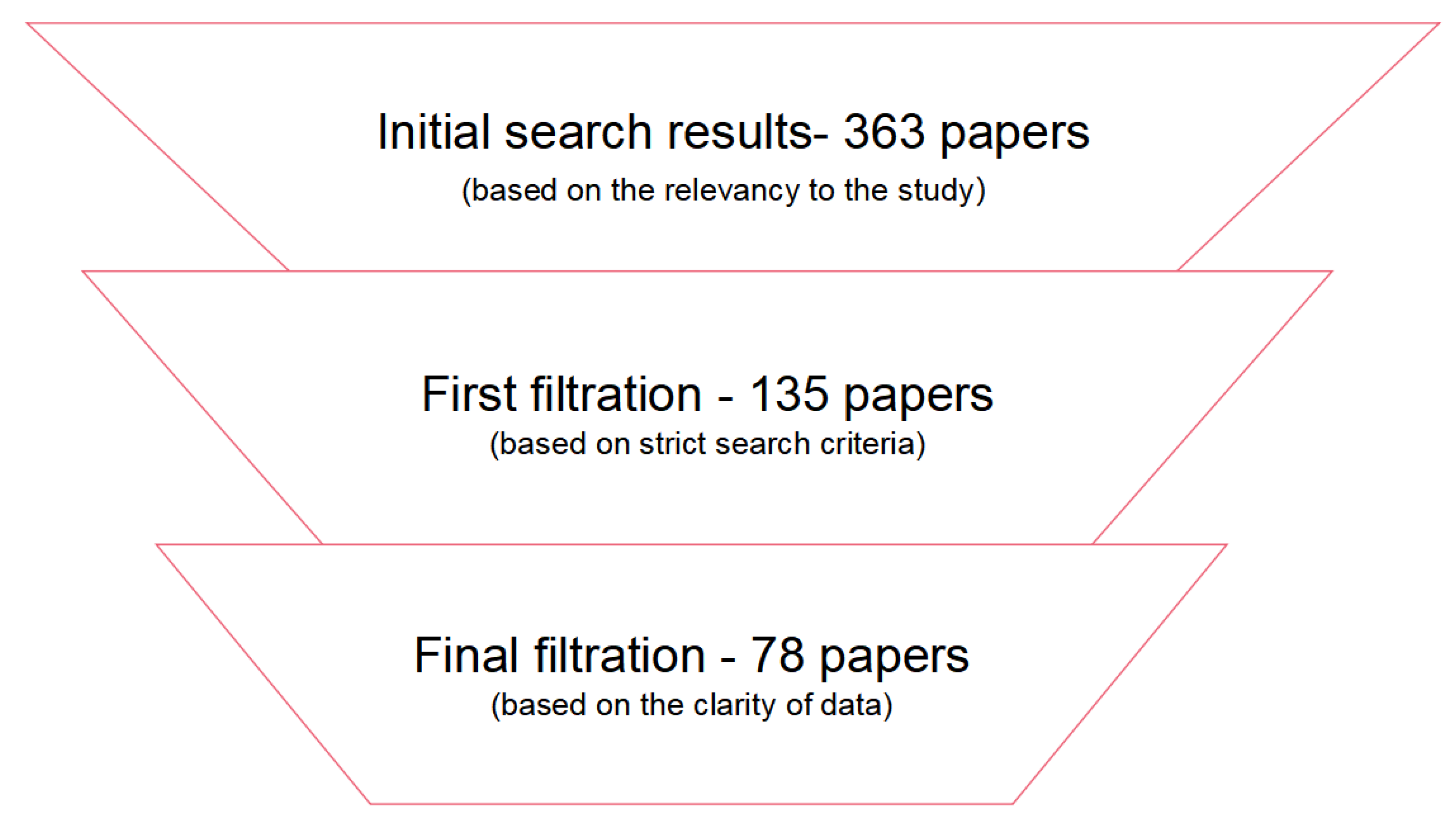
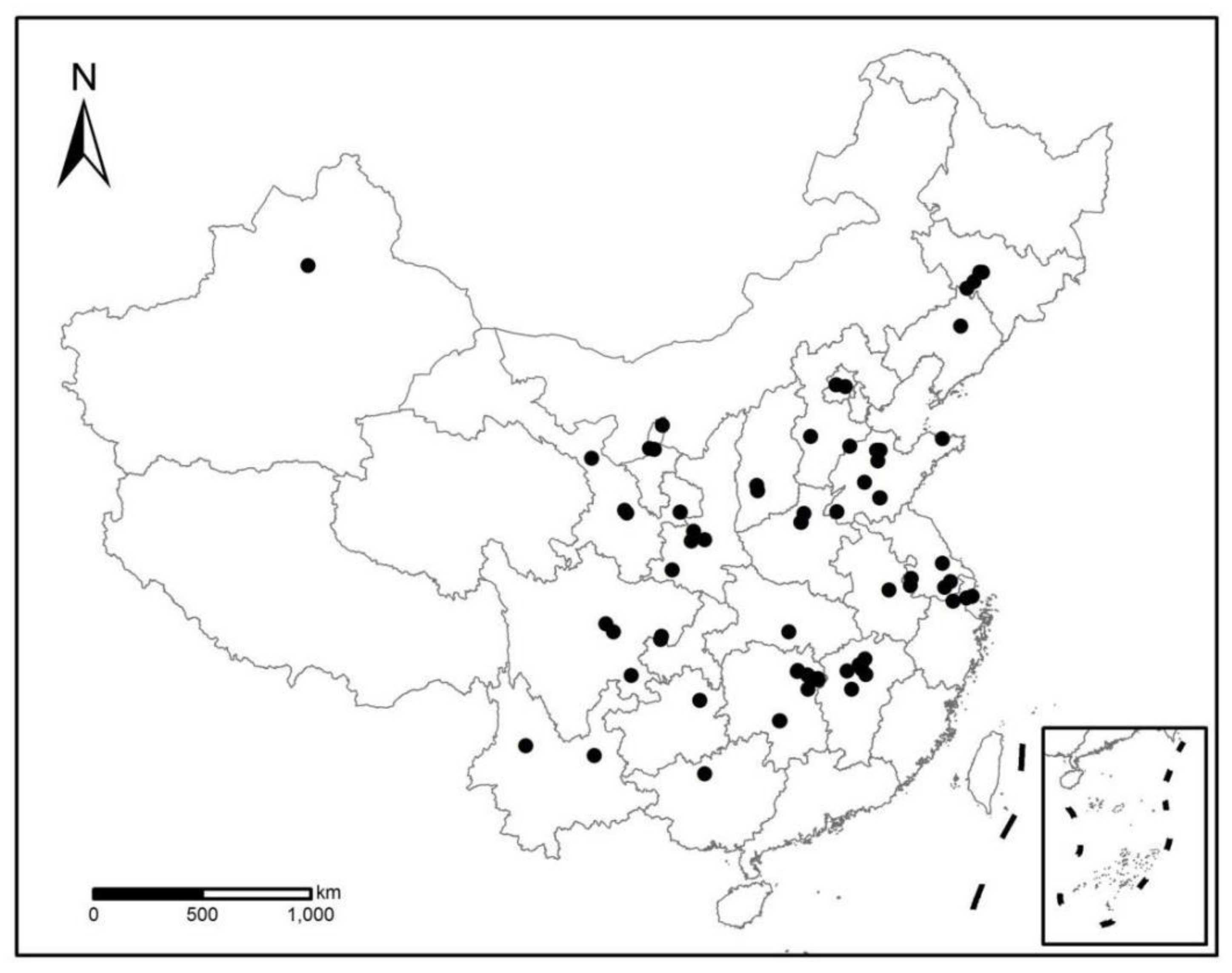
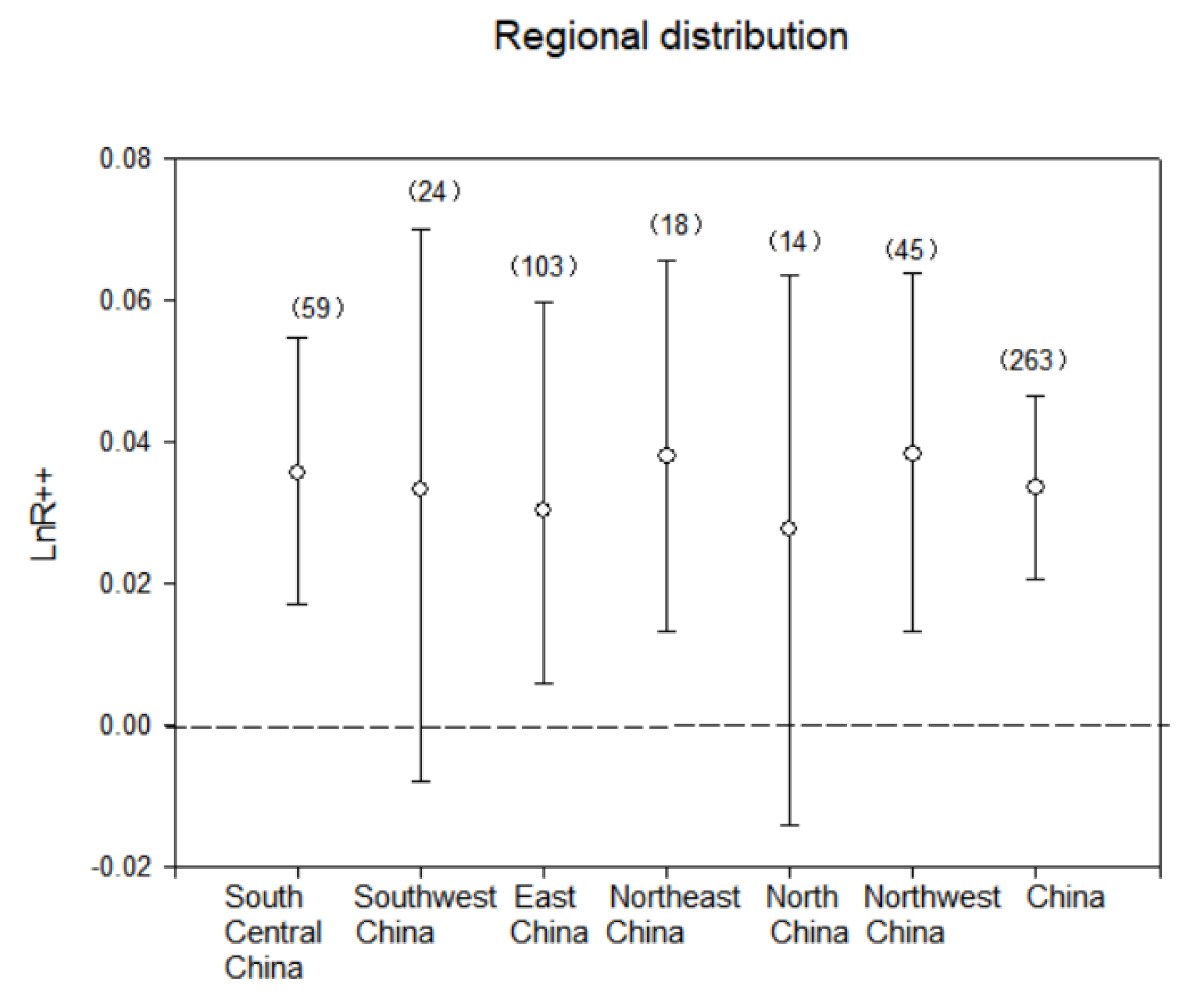
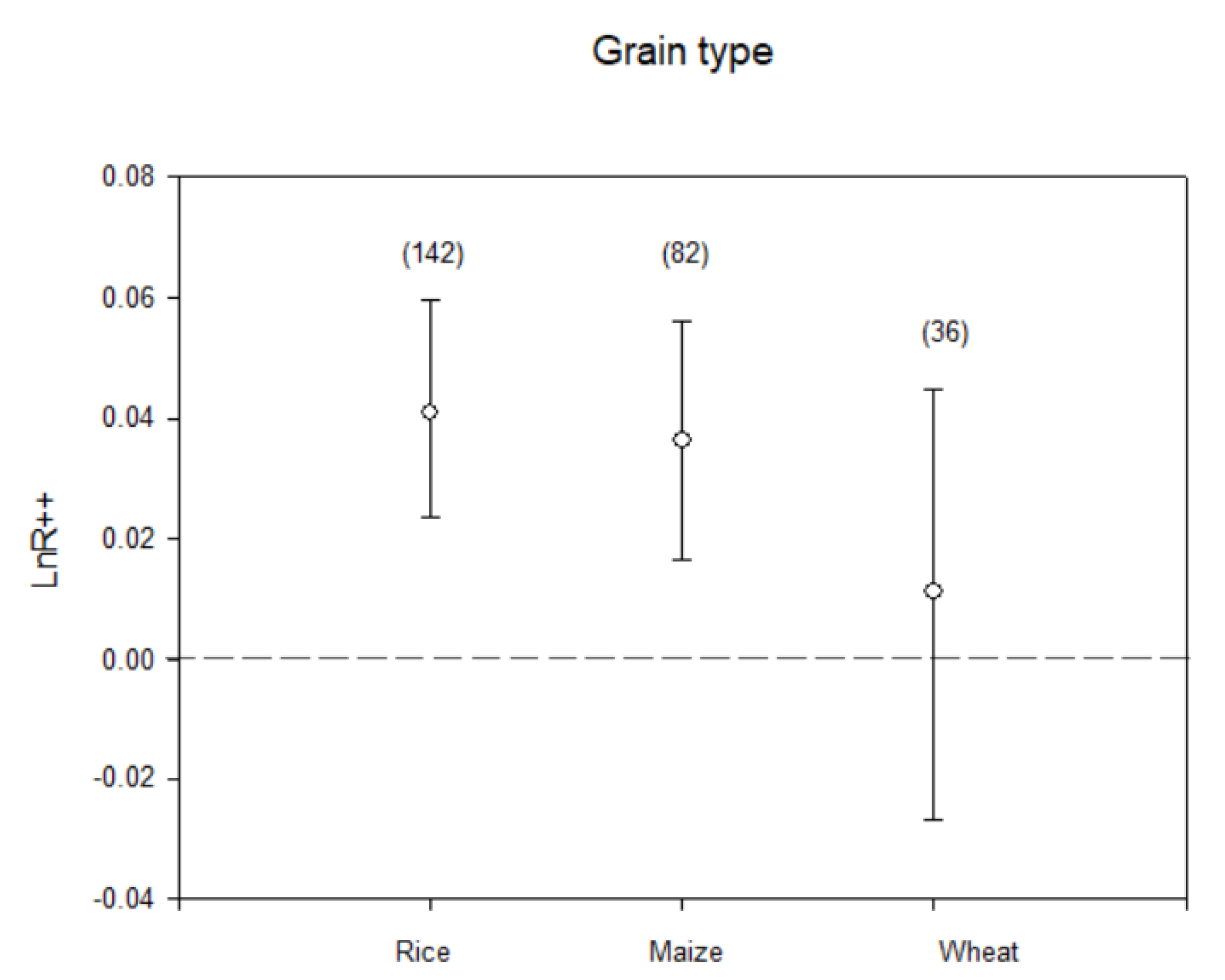

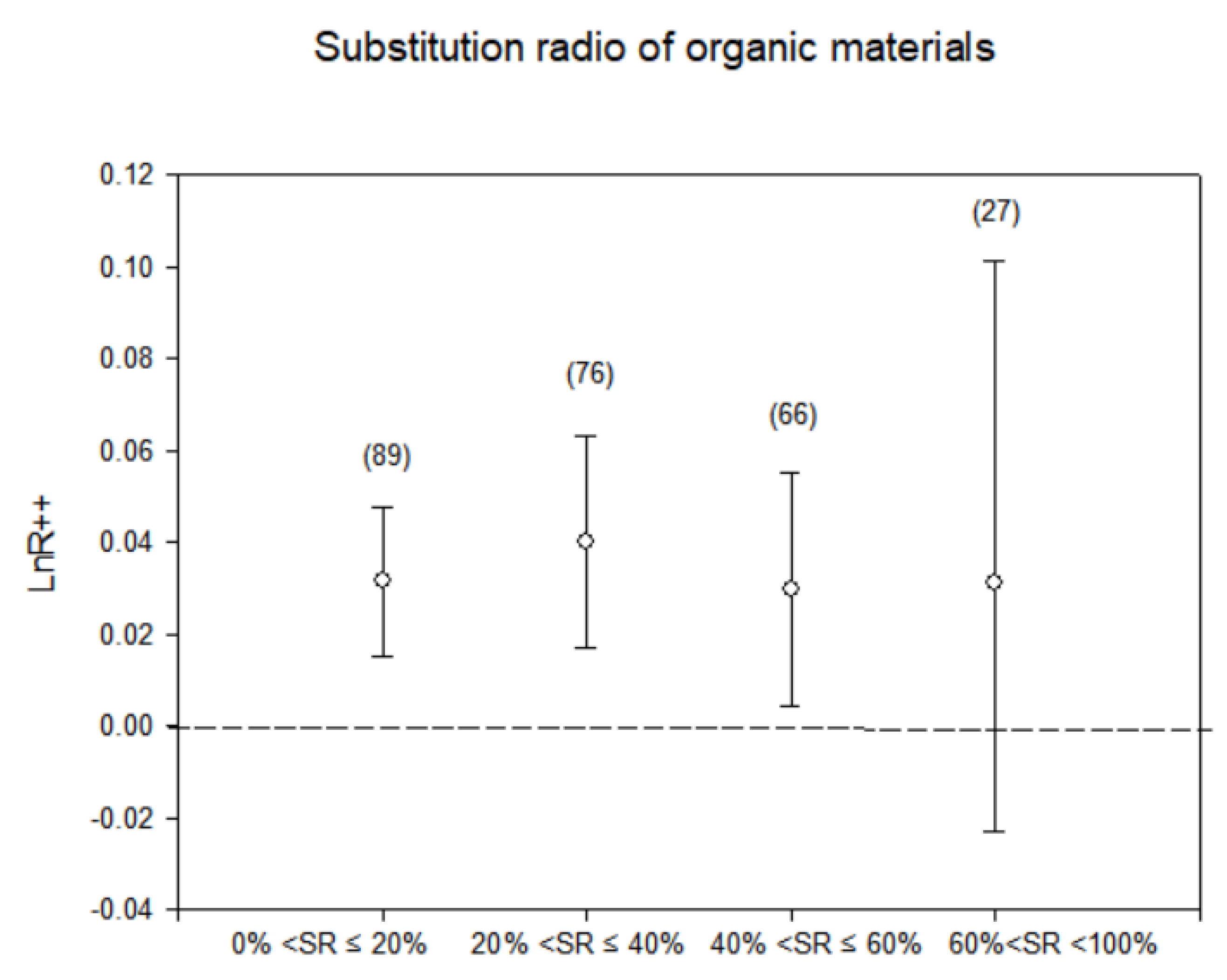
| Item | Regional Distribution | Type of Organic Materials | Substitution Ratio (SR) | Grain Type |
|---|---|---|---|---|
| Grouping | East China North China Southwest China Northeast China Northwest China Center South China | Cow dung Chicken manure Pig manure Straw Biochar Biogas residue | 0 < SR ≤ 20% 20 < SR ≤ 40% 40% < SR ≤ 60% 60% < SR < 100% | Maize Wheat Rice |
| Regional Distribution | Prevailing Soil Type | Prevailing Climate | Summary Soil PH | Soil Carbon |
|---|---|---|---|---|
| East China | Medium loam | Subtropical humid monsoon climate, temperate monsoon climate | 5.39–8.56 | medium |
| North China | Medium loam | Temperate continental monsoon climate | 11.9–21.50 | medium |
| Southwest China | Sandy loam | Subtropical monsoon climate | 5.59–7.57 | super |
| Northeast China | Clay loam | Monsoon climate of medium latitudes | 6.01–7.60 | super |
| Northwest China | Medium loam | Temperate continental monsoon climate | 6.58–8.79 | medium |
| Center South China | Loam | Subtropical humid monsoon climate | 5.10–8.05 | super |
Publisher’s Note: MDPI stays neutral with regard to jurisdictional claims in published maps and institutional affiliations. |
© 2021 by the authors. Licensee MDPI, Basel, Switzerland. This article is an open access article distributed under the terms and conditions of the Creative Commons Attribution (CC BY) license (https://creativecommons.org/licenses/by/4.0/).
Share and Cite
Fan, X.; Chen, Z.; Niu, Z.; Zeng, R.; Ou, J.; Liu, X.; Wang, X. Replacing Synthetic Nitrogen Fertilizer with Different Types of Organic Materials Improves Grain Yield in China: A Meta-Analysis. Agronomy 2021, 11, 2429. https://doi.org/10.3390/agronomy11122429
Fan X, Chen Z, Niu Z, Zeng R, Ou J, Liu X, Wang X. Replacing Synthetic Nitrogen Fertilizer with Different Types of Organic Materials Improves Grain Yield in China: A Meta-Analysis. Agronomy. 2021; 11(12):2429. https://doi.org/10.3390/agronomy11122429
Chicago/Turabian StyleFan, Xiaoru, Zekai Chen, Zihan Niu, Ruiyao Zeng, Jingmin Ou, Xingxing Liu, and Xiaolong Wang. 2021. "Replacing Synthetic Nitrogen Fertilizer with Different Types of Organic Materials Improves Grain Yield in China: A Meta-Analysis" Agronomy 11, no. 12: 2429. https://doi.org/10.3390/agronomy11122429
APA StyleFan, X., Chen, Z., Niu, Z., Zeng, R., Ou, J., Liu, X., & Wang, X. (2021). Replacing Synthetic Nitrogen Fertilizer with Different Types of Organic Materials Improves Grain Yield in China: A Meta-Analysis. Agronomy, 11(12), 2429. https://doi.org/10.3390/agronomy11122429






